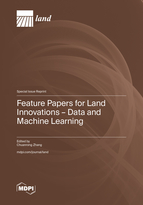Feature Papers for Land Innovations – Data and Machine Learning
A special issue of Land (ISSN 2073-445X). This special issue belongs to the section "Land Innovations – Data and Machine Learning".
Deadline for manuscript submissions: closed (27 October 2023) | Viewed by 30975
Special Issue Editor
Interests: geographical information science and systems; cyberinfrastructure; land use and land cover; spatial data analysis
Special Issues, Collections and Topics in MDPI journals
Special Issue Information
Dear Colleagues,
The Special Issue “Feature Papers for Land Innovations – Data and machine learning” welcomes contributions relating to spatial data science for obtaining, processing, analyzing, harnessing, and visualizing social, economic, environmental, and other data related to Land. Particularly, it welcomes geospatial artificial intelligence and machine learning techniques for dealing with spatial big data, including remotely sensed data and social media data. Manuscripts can be theoretical, applied, or review articles. Interdisciplinary manuscripts are particularly welcome.
Prof. Dr. Chuanrong Zhang
Guest Editor
Manuscript Submission Information
Manuscripts should be submitted online at www.mdpi.com by registering and logging in to this website. Once you are registered, click here to go to the submission form. Manuscripts can be submitted until the deadline. All submissions that pass pre-check are peer-reviewed. Accepted papers will be published continuously in the journal (as soon as accepted) and will be listed together on the special issue website. Research articles, review articles as well as short communications are invited. For planned papers, a title and short abstract (about 100 words) can be sent to the Editorial Office for announcement on this website.
Submitted manuscripts should not have been published previously, nor be under consideration for publication elsewhere (except conference proceedings papers). All manuscripts are thoroughly refereed through a single-blind peer-review process. A guide for authors and other relevant information for submission of manuscripts is available on the Instructions for Authors page. Land is an international peer-reviewed open access monthly journal published by MDPI.
Please visit the Instructions for Authors page before submitting a manuscript. The Article Processing Charge (APC) for publication in this open access journal is 2600 CHF (Swiss Francs). Submitted papers should be well formatted and use good English. Authors may use MDPI's English editing service prior to publication or during author revisions.






